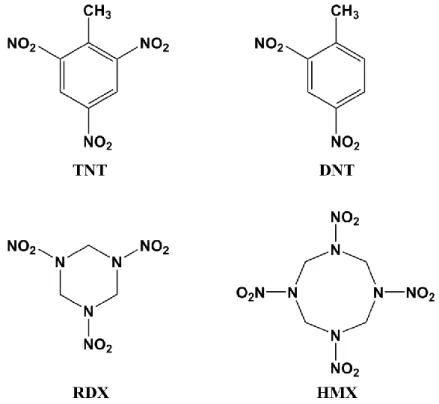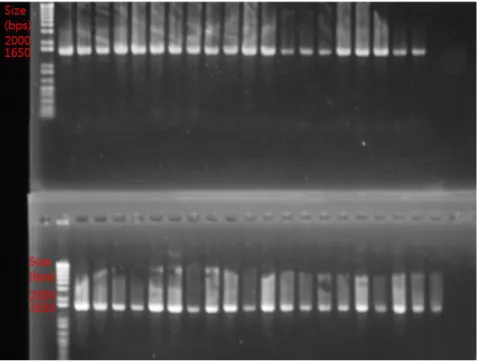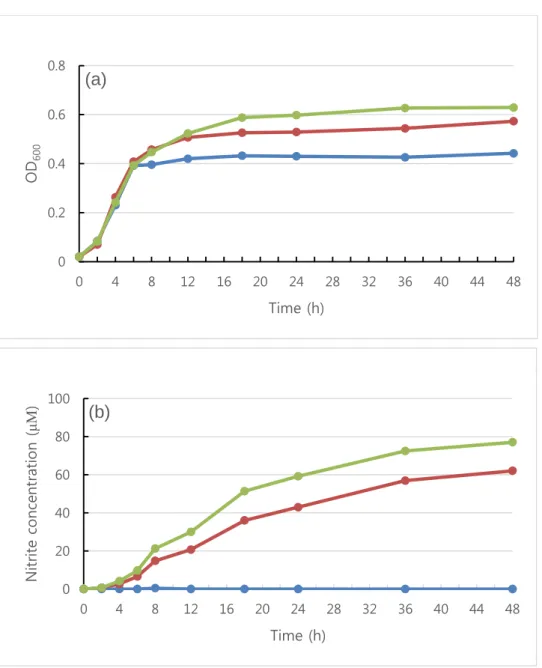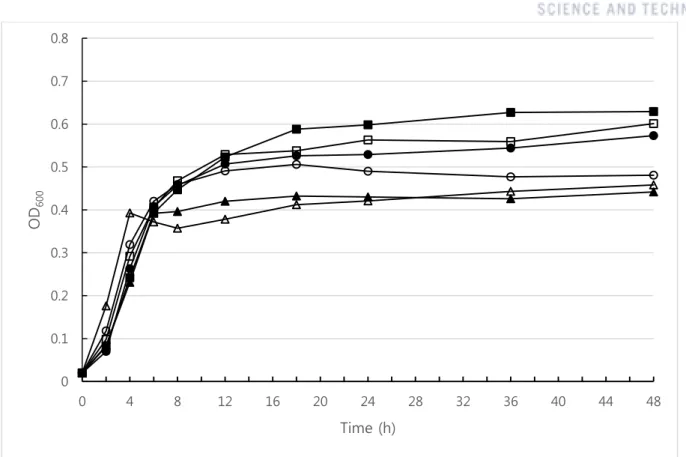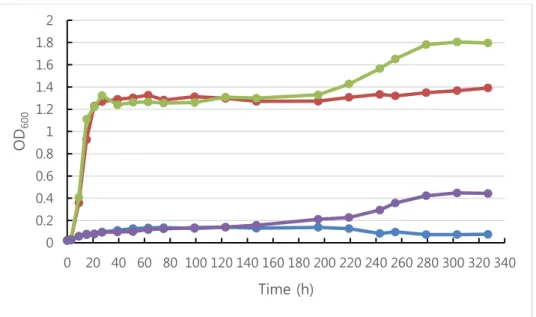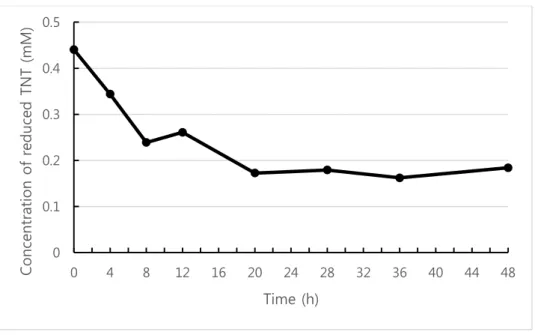However, it is recalcitrant due to its physical and chemical properties, so the complete removal of TNT is considered difficult. To solve the environmental problem caused by TNT, bioremediation using microorganisms has recently been introduced as one of the methods to remove the explosives, especially TNT. For this purpose, we isolated and identified the bacterial strains that can grow in TNT and break it down to reduce its toxicity, from the Korean Army's firing range at the front and rear of Korea.
The strain with high similarity to Pseudomonas putida, which occupies dominant numbers after isolation and selection, is chosen for this study and shows utilization of TNT as sole nitrogen source in TNT-containing medium and release of nitrite and degradation of TNT as detoxification of TNT. We expect that the strain can be used for cleaning and handling TNT-contaminated soil. Growth of isolated bacterial sample strain in TNT-containing medium and concentration of released nitrite in supernatant.
Growth of D1-1 test strain using TNT as sole nitrogen source and limiting nitrogen source for NH4Cl.
Introduction
Nitro compound explosives
Among them, 2,4,6-trinitrotoluene has been one of the most widely used nitro compound explosives in the military and construction industries since the first synthetic method was developed by Joseph Wilbrand in 1863. In addition, the production of nitro compound explosives as well as TNT has been increased explosively since the Haber process was invented to produce ammonium (NH4+) ion which is the source of explosives in production during World War 1 and because of its chemical properties such as its low melting point, its stability, low sensitivity to shock, friction and high temperature.5 However, its symmetrically stable structure as nitro groups attached to the aromatic ring of TNT makes it recalcitrant in the removal of TNT. In TNT-contaminated soil after use, TNT should be removed because it leads to DNA damage2 and mutations3 to organisms behind its convenient use in various areas that need explosion.
There are many methods that struggle to remove TNT from contaminated soil, but they fail to remove TNT completely. Finally, bioremediation using microorganisms may be the only way to detoxify TNT and use TNT as a nitrogen and carbon source.
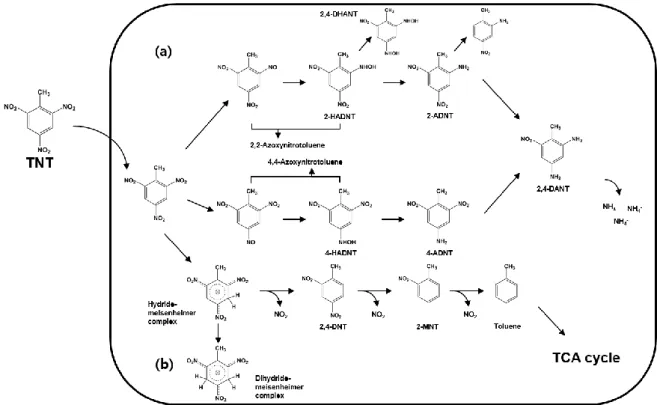
TNT metabolism in microorganisms
In addition to the release of nitrite, the nitro group can be reduced to an amino group with the formation of a hydroxylamino group (Figure 2a). During the reduction of the nitro group attached to the aromatic ring of TNT, which is not released from TNT, the enzyme reductase, which is nonspecifically directed to the nitro group, participates in the formation of hydroxylaminodinitrotoluene (HADNT), followed by the production of aminodinitrotoluene (ADNT). In the production process, HADNT can react with an intermediate containing a nitrosonium (NO+) ion to produce azoxynitrotoluene.14 Intermediates from reduced TNT are known to be relatively less toxic to organisms than TNT.
In addition, an amino group, a reduced form of a nitro group, can be released and reduced to ammonium ions, which can be used as a nitrogen source other than the release of nitrite. In the TNT biodegradation pathway, various forms of intermediates are produced and the mechanisms are very diverse depending on the bacterial strains that have biodegradability for TNT. This complex biodegradation mechanism may allow the bacterial strains to remove TNT as part of bioremediation.
Identification of unknown bacterial strains
Materials and methods
- Enrichment to screen bacterial strains grown in TNT
- Selection of bacterial strains isolated from enrichment culture
- Identification and grouping
- Growth condition
- Nitrite assay
- Growth condition for utilization of TNT as sole nitrogen source
- HPLC analysis for measuring reduced concentration of TNT
Representative bacterial stain occupying a dominant number due to enrichment and grouping, T1, the closest strain as P. The strains used in the experiment were incubated in 5 ml of LB medium for 16 hours and then inoculated into 50 ml of M8 medium as 1 : 100 dilution factor. The concentration of nitrite accumulated in the supernatant of the culture medium was determined colorimetrically using the Griess reaction with a related reagent.
The composition of the culture medium was defined to limit the nitrogen source and confirm the use of TNT as the sole nitrogen source as M8 medium, which is identical to the composition of M9 medium without nitrogen source (NH4Cl), consisting of 22.0 mM KH2PO4 , 47.8 mM Na2HPO4, 8.56 mM NaCl, 831 μM MgSO4. The strain used in the experiment was incubated in 5 ml of M9 medium for 16 h and then inoculated into 50 ml of four-independent medium at a dilution factor of 1:100. The culture supernatants were acidified with 1N HCl 160 μl per 1 ml of sample and then extracted twice with an equal volume of ethyl acetate.
Results
- Selection of the bacterial strains expect to degrade TNT
- Identification and grouping
- Growth of D1-1 samples strain in TNT and release of nitrite
- Utilization of TNT as sole nitrogen source in growth
- HPLC analysis for biodegradation of TNT
In addition, TNT was supplied according to the concentration as 100mg and 200mg per liter to confirm the toxicity of TNT for the growth of bacteria. In figure 6a, the growth curve shows the strain can grow in TNT-containing medium and grow better when the higher concentration of TNT is supplied than when no TNT is supplied. Originally, the strain that lacked the enzyme involved in the removal of the nitro group from the aromatic ring of TNT could not survive in the environment surrounded by TNT.
Although the strain reaches the stationary phase in growth, the concentration of accumulated nitrite continuously increases due to the enzymatic reaction associated with the release of nitro group from the aromatic ring of TNT. Moreover, the final OD at the stationary phase is gradually higher with increased TNT concentration supplied from no TNT to 200mg/L TNT. So we check the growth to confirm the utilization of TNT as sole nitrogen source by limiting nitrogen source.
However, the model strain D1-1 shows a much higher final OD at each TNT concentration provided by 100 mg and 200 mg TNT per liter. A further growth study was conducted to confirm the use of TNT as the sole source of nitrogen. In a growth experiment using media containing yeast extract, increased growth at the final OD in the stationary phase was shown in relation to the increased concentration of TNT provided.
The release of nitrite from the aromatic ring of TNT may be a trace of TNT detoxification as a way of removing the nitro group. However, to confirm the biodegradation of TNT, a quantitative analysis for the concentration of reduced TNT when the cell is cultured in medium containing TNT is required. In a growth study using model strain D1-1 in medium containing yeast extract, 1 mL samples were collected from culture medium initially containing 0.44 mM (100 mg/L) TNT to verify the reduced TNT concentration with HPLC analysis.
As control groups, no peak was detected in the culture medium without TNT supplied, and the concentration of the medium including 0.44 mM TNT without the strain shows no degradation of TNT. As the strain grew in the medium, nitrite was released from the aromatic ring of TNT (Fig. 6b), and the concentration of TNT also decreased to the concentration of ~0.18 mM (~40 mg/L), which shows more. than half of TNT was broken down.
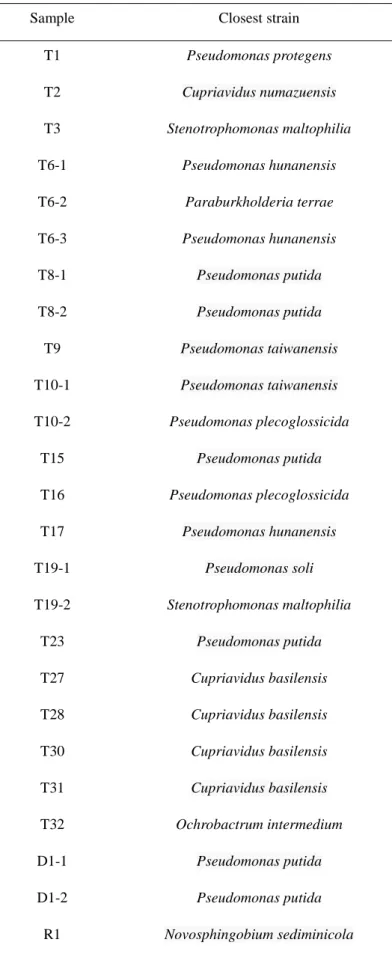
Discussion
- Selection, identification and grouping
- Bioremediation of TNT in microorganisms
- Utilization of TNT as nitrogen source and biodegradation of TNT
- Future research plan
In the bioremediation using microorganisms, complete removal of TNT by microbial degradation means the reduction and release of nitrogen functional group from the aromatic ring of TNT followed by the utilization as nitrogen source and the breaking of C-skeleton with nitro group detached, through amphibolic intermediates , which ultimately produces CO2.6 However, the utilization of C-skeleton, mostly toluene, has rarely been reported. Thus, the removal of nitro group from the aromatic ring of TNT is sufficient to decrease the toxicity of TNT. D1-1 sample strain shows the release of nitrite, which may be the trace of reduction of TNT.
The actual reduced concentration of TNT should be measured by quantitative HPLC analysis. In a growth experiment in media containing yeast extract, an increased growth of the final OD in the stationary phase was shown according to the increased concentration of TNT. In the experiment that confirmed the use of TNT as the sole source of nitrogen, a medium with a limited source of nitrogen and a sufficient addition of a source of carbon was composed.
The nitro group liberated from the aromatic ring of TNT can be used as a nitrogen source in the growth of bacterial strain that can degrade TNT, which can be further reduced to ammonium ion and used through the metabolic pathway that utilizes ammonium after ammonium ion by 5 mM NH 4 Cl. it was all used33. As described in the mechanism for biodegradation of TNT, there are various intermediates present in microorganisms and produced by the degradation of TNT as diverse reduced forms in complex mechanisms in different microorganisms. In the growth study, nitrite ions were released and accumulated in the supernatant, and TNT degradation was observed by quantitative analysis using HPLC.
Thus, we can recognize an increased concentration of nitrite in the culture medium and a decreased concentration of TNT as a trace of TNT biodegradation. However, there are other routes to reduce the nitro group attached to the aromatic ring of TNT without release. In previous studies, the Pseudomonas strain is slowly grown in a weekly culture to reach its stationary phase, and the final OD in the stationary phase is very low around 0.5-0.6 when incubated in a medium containing only the use of TNT as a nitrogen source with the addition of a carbon source in minimal media, although.
Conclusions
M; de Lorenzo, V., Engineering quasi-natural Pseudomonas putida strains for toluene metabolism via anortho-cleavage degradation pathway. Osada, Y.; Saito, R.; Tomita, M., Analysis of base pair potentials between 16S rRNA and 5'UTR for translation initiation in various prokaryotes. K; Lim, Y.-W., EzTaxon: a web-based tool for the identification of prokaryotes based on 16S ribosomal RNA gene sequences.
